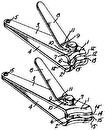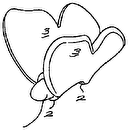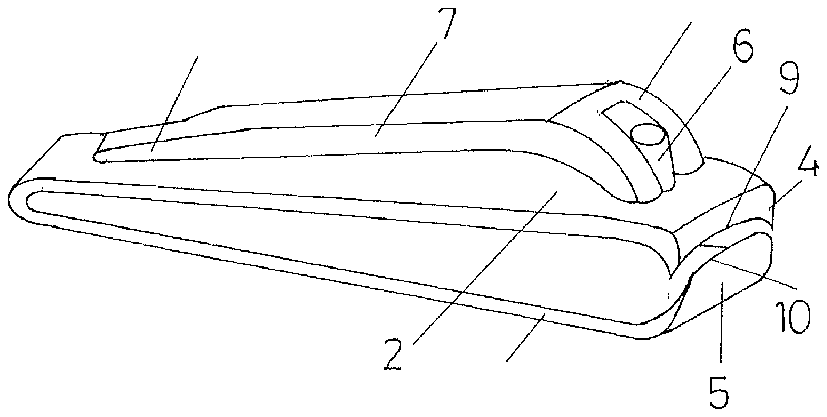
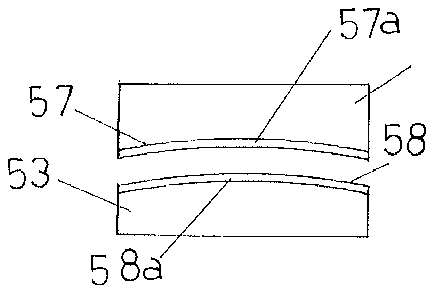
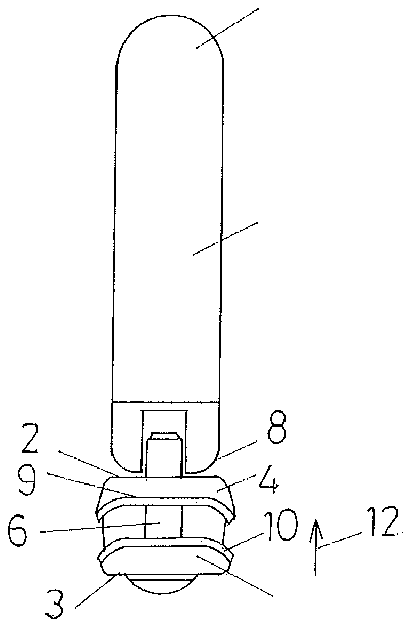
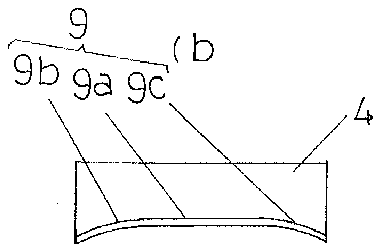
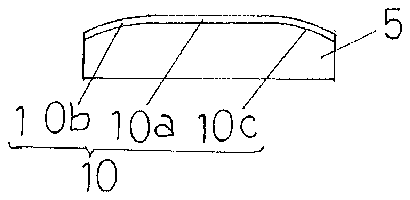
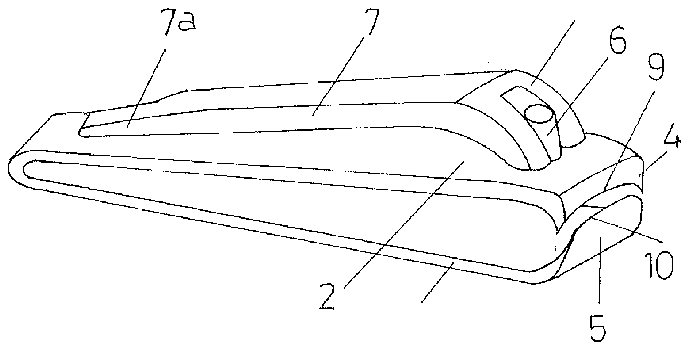
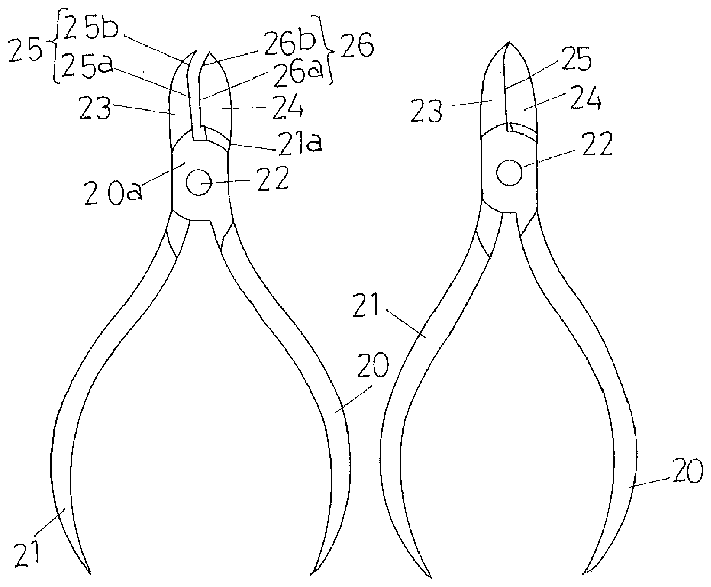
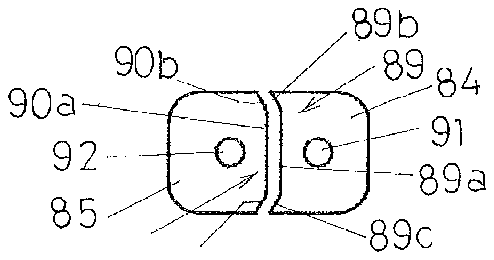
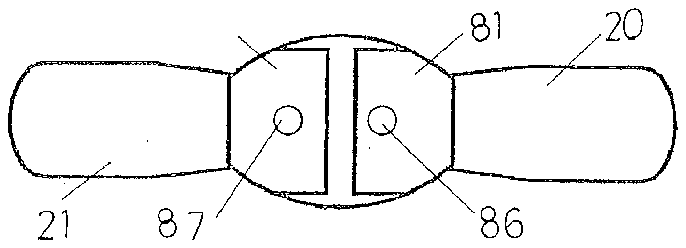
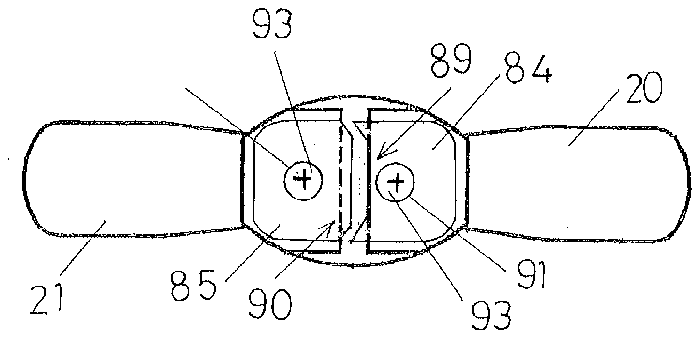
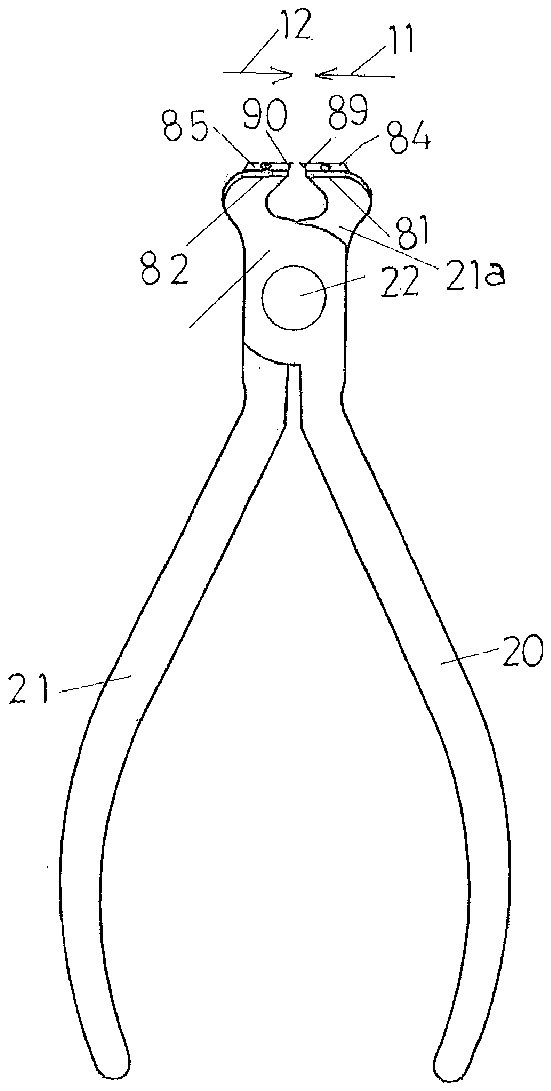
- 1nail clippers
- 2upper plate
- 3lower plate
- 4cutting blade
- 5cutting blade
- 6support pin
- 7press-down operating plate
- 8lever-acting portion
- 9curved portions
- 10cutting edge
- 11two opposed arrows
- 20levers
- 21hinge portion
- 22shaft
- 23cutting blade
- 24cutting blade
- 25straight line portions
- 26cutting edge
- 27two opposed arrows
- 29two opposed arrows
- 31nail clippers
- 50upper plate
- 51lower plate
- 52cutting blade
- 53cutting blade
- 54support pin
- 55press-down operating plate
- 56lever-acting portion
- 57upper cutting edge
- 58lower cutting edge
- 60two opposed arrows
- 71hinge portion
- 72shaft
- 73cutting blade
- 74cutting blade
- 75two opposed arrows
- 77two opposed arrows
- 80nail clippers
- 81ponding cutting blade mounting portions
- 84cutting blades
- 86threaded holes
- 90cutting edge
- 91mounting holes
- 92metal
Abstract
The nail clippers are designed for bringing one cutting edge formed on a tip of the one cutting blade closer to the other cutting edge, the one cutting edge and the other cutting edge being disposed facing opposite each other and holding a particular nail being to be cut between the two opposed cutting edges to cause the two opposed cutting edges to engage each other and cut that particular nail. The one cutting edge and the other cutting edge have, respective straight line portions which face opposite each other and extend parallel to each other and respective curved portions which are provided contiguously to the corresponding straight line portions and which are curved and extended at a curvature that permits the one curved portion to exactly match the other curved portion when they meet each other.
Description
BACKGROUND
[0001] 1. Technical Field
[0002] The present invention relates to a pair of nail clippers. More particularly, the present invention relates to the pair of nail clippers which are suitable for cutting the nails on the human fingers and toes gently and softly without causing any unnatural deformations to the nails when they are to be cut.
[0003] When the term for the pair of nail clippers is referred to herein, it includes two types of nail clippers such as the clip-type pair of nail clippers and the nipper-type pair of nail clippers which may take the form of nail scissors.
[0004] 2. Description of the Prior Art
[0005] There are many different types of nail clippers that have been proposed heretofore, in which one typical example of such pairs of nail clippers comprises two cutting blades facing opposite each other, one of the two opposed cutting blades having a cutting edge formed on a tip of the one cutting blade and the other of the two opposed cutting blades having a cutting edge formed on a tip of the other cutting blade, and is designed so that the nails can be cut by bringing the two opposed cutting edges closer to each other and holding a particular nail being to be cut between the two opposed cutting edges thus brought closer to each other to cause the two opposed cutting edges to engage each other and cut that particular nail.
[0006] As it will be described below, there are also other types of nail clippers that have been proposed heretofore, which take into account the shapes of the human nails and are specifically designed for cutting the nails gently and softly without causing any unnatural deformations to the nails when they are being to be cut (Patent Documents 1 and 2, for example).
[0007] FIG. 1 ( a ) and ( b ) and FIG. 2 illustrate one typical example of the conventional pairs of nail clippers. Specifically, FIG. 1 ( a ) and ( b ) represent the clip-type pair of nail clippers, and FIG. 2 represents the nipper-type pair of nail clippers.
[0008] For the clip-type nail clippers, it is general that an upper plate 50 and a lower plate 51 are joined together into one unit on the base end sides thereof (on the rear sides in FIG. 1 ( a )), and a cutting blade 52 and a cutting blade 53 are formed on the respective tips of the upper and lower plates 50 and 51 (on the front sides in FIG. 1 ( a )) so that they can face opposite each other. The upper and lower plates 50 and 51 are joined together by means of a support pin 54 that is inserted vertically into the respective tips of the upper and lower plates 50 and 51 . On the upper end of the support pin 54 thus inserted through the upper plate 50 , the base end side of a press-down operating plate 55 (on the lower side in FIG. 1 ( a )) is supported so that it can be turned pivotally.
[0009] On the base end side of the press-down operating plate 55 , a lever-acting portion 56 is provided. In the state in which the lever-acting portion 56 is directed downwardly to engage the upper surface of the upper plate 50 as shown in FIG. 1 ( a ), the tip side 55 a of the press-down operating plate 55 (the upper side in FIG. 1 ( a )) may be pressed downwardly so that it can be turned about the base end side of the press-down operating plate 55 pivotally supported by the support pin 54 . This will allow the lever-acting portion 56 to press the upper side of the upper plate 50 downwardly, causing the cutting edge 57 formed on the tip of the upper cutting blade 52 and the cutting edge 58 formed on the tip of the lower cutting blade 53 to be moved closer to each other as indicated by two opposed arrows 60 and 61 . In this way, a particular nail being to be cut (not shown) will be held between the upper cutting edge 57 and the lower cutting edge 58 that faces opposite the upper cutting edge 57 so that that particular nail will be ready to be cut.
[0010] For the nipper-type pair of nail clippers, it is general that two levers are provided in which one lever is shown by 71 and has a hinge portion 71 a, and the other lever is shown by 70 and has a hinge portion 70 a. A shaft 72 is rigidly fixed to the hinge portion 71 a of the one lever 71 and the hinge portion 70 a of the other lever 70 is pivotally mounted on the shaft 72 . A cutting blade 73 and a cutting blade 74 are formed on the respective tip sides of the levers 70 and 71 so that they can face opposite each other. The cutting blade 73 and the cutting blade 74 include respective cutting edges (not shown), which are formed on the corresponding tips thereof so that they can face opposite each other. Those cutting edges are curved at a particular curvature that permits the curved shape of the one cutting edge to exactly match the corresponding curved shape of the other cutting edge when they meet each other. In one typical example of the conventional cutting edges, the cutting edge formed on the tip of the cutting blade 73 is curved like the convex shape while the cutting edge formed on the tip of the cutting blade 74 is curved like the concave shape.
[0011] Gripping the levers 70 and 71 with the fingers of one free hand (left or right) and then rotating them about the shaft 72 as indicated by two opposed arrows 75 , 76 will cause the cutting edge formed on the tip of the one cutting blade 73 and the cutting edge formed on the tip of the other cutting blade 74 to be brought closer to each other as indicated by two opposed arrows 77 , 78 . In this way, a particular nail to be cut (not shown) will be held between the two cutting edges facing opposite each other and will be ready to be cut.
[0012] It should be understood that the nails on the human fingers and toes that are to be cut present very different forms or shapes when they are viewed from the tip sides of the nails. For example, when a particular nail is viewed from the tip side of that particular nail, it is curved downwardly as it goes from the middle portion toward the left and right sides. Some nails may be flat on the middle portion and may be curved on the left and right sides. Other nails may be entirely flat on the middle portion and on the left and right sides when they are viewed from their tip sides.
[0013] The prior art pairs of nail clippers as proposed heretofore and presented as examples in FIG. 1 ( a ), ( b ) and FIG. 2 are designed to take into account the shapes and forms of the human nails such as the ones mentioned above. In one typical example of the conventional pairs of nail clippers as presented in FIG. 1 ( a ), ( b ). it may be apparent that the upper cutting edge 57 and the lower cutting edge 58 facing opposite each other have the respective shapes and forms such that they are curved downwardly at the particular curvature that permits the curved shape of the upper cutting edge 57 to exactly match the corresponding curved shape of the lower cutting edge 58 when they meet each other as those cutting edges go farther away from the respective middle portions 57 a, 58 a toward the respective left and right sizes. In another typical example of the conventional pairs of nail clippers as presented in FIG. 2 , the cutting edges of the one and other cutting blades 73 , 73 facing opposite each other are curved at the particular curvature that permits the curved shape of the one cutting edge to exactly match the corresponding curved shape of the other cutting edge such that the one cutting edge has the convex shape while the other cutting edge has the concave shape. In this example, the conventional pair of nail clippers take into account the shapes or forms of the nails on the human fingers and toes, and are designed so that the nails can be cut gently and softy without causing any unnatural deformations to the nails when they are to be cut.
PRIOR TECHNICAL DOCUMENTS
Patent Documents
[0014] Patent Document 1: Patent application No. 2002-46142
[0015] Patent Document 2: U.S. Pat. No. 4,637,137
SUMMARY OF THE INVENTION
[0016] There are many different types of nail clippers which have been proposed heretofore, in which the pair of nail clippers take into account the shapes or forms of the nails on the human fingers and toes, and are designed so that the nails can be cut gently and softly without causing any unnatural deformations to the nails when they are being cut. It should be noted, however, that those conventional pairs of nail clippers remain yet to be improved.
[0017] In light of the above, therefore, the object of the present invention is to provide the pair of nail clippers that take into account the shapes or forms of the nails on the human fingers and toes and are suitable for cutting the nails more gently and softly without causing any unnatural deformations to the nails when they are being cut.
[0018] The invention according to claim 1 provides a pair of nail clippers which comprise two cutting blades facing opposite each other, one of the two opposed cutting blades having a cutting edge formed on a tip of the one cutting edge and the other of the two opposed cutting blades having a cutting edge formed on a tip of the other cutting blade, and are designed for cutting the nails on the human fingers and toes by bringing the two opposed cutting edges closer to each other, holding a particular nail being to be cut between the two opposed cutting edges thus brought closer to each other and thereby causing the two opposed cutting edges to engage each other, wherein the cutting edge of the one cutting blade and the cutting edge of the other cutting blade include:
[0019] respective straight line portions that are provided to face opposite each other and extend parallel to each other in a direction perpendicular to the direction in which the two opposite cutting edges are moved closer to each other and
[0020] respective curved portions that are provided to be contiguous to the above corresponding straight line portions and to he curved and extended at a curvature that permits the one cutting edge to exactly match the other cutting edge when they meet each other.
[0021] The invention according to claim 2 provides a pair of nail clippers as defined in claim 1 , wherein each of said curved portions is formed on both sides of each corresponding of said straight line portions in the direction in which each of said straight line portions extends.
[0022] The invention according to claim 3 provides a pair of nail clippers as defined in claim 1 , wherein each of said curved portions is only formed on one side of each corresponding one of said straight line portions in the direction in which each corresponding one of said straight line portions extends.
[0023] The invention according to claim 4 provides a pair of nail clippers as defined in claim 1 or 2 , wherein the one cutting blade and the other cutting blade facing opposite each other are provided separately from each other by cutting a single place into two separate parts along the center line thereof, the one part of which provides the one cutting edge portion and the other part of which provides the other cutting edge portion, the one cutting edge portion having a tip edge so formed as to face opposite the other cutting edge portion and which serves as the one cutting edge and the other cutting edge portion having a tip edge so formed as to face opposite the one cutting edge portion and which serves as the other cutting edge or vice versa.
[0024] The invention according to claim 5 provides a pair of nail clippers as defined in claim 4 , further including one pair of cutting edge supporting members that are provided so that they can be moved closer to or farther away from each other and wherein the one cutting blade and the other cutting blade can be attached to or detached from the tips of the corresponding cutting edge supporting members, respectively.
[0025] The present invention provides a pair of nail clippers that have advantages and features that distinguish the present invention from any other prior art pairs of nail clippers, in that the pair of nail clippers of the present invention take into account the shapes of the nails on the human fingers and toes, and are designed to be suitable for cutting the nails more gently and softly when they are being cut without causing any unnatural deformations to the nails.
BRIEF DESCRIPTION OF DRAWINGS
[0026] FIG. 1 represents one typical example of the conventional clip-type pairs of nail clippers, wherein (a) shows a front view of the example of the pairs nail clipper in which they are in use and (b) shows an enlarged front view of the cutting edges facing opposite each other in the example of the pairs of nail clippers represented in FIG. 1 ( a );
[0027] FIG. 2 represents one example of the conventional nipper-type pairs of nail clippers;
[0028] FIG. 3 represents one example of the clip-type pairs of nail clippers according to the present invention, wherein (a) shows a front view of the example of the pair of nail clippers in which they are in use and (b ) shows an enlarged front view of the cutting edges facing opposite each other in the example of the pair of nail clippers represented in FIG. 3 ( a );
[0029] FIG. 4 shows a perspective view of the clip-type pair of nail clippers of the present invention shown in FIG. 3 in which they are not in use with some parts or elements being omitted;
[0030] FIG. 5 represents one example of the nipper-type pair of nail clippers of the present invention, wherein (a) shows a side view of the pair of cutting edges facing opposite each other in which they are in the opened state and (b) shows a side view of the pair of cutting edges facing opposite each other in which they are in the closed state;
[0031] FIG. 6 ( a ) is a plan view of the cutting blades in the pair of nail clippers of the present invention, and illustrates how those cutting blades can be provided by cutting a single plate along the center line thereof into two separate parts, (b) is a plan view illustrating the tips of a pair of cutting edge supporting members to which the corresponding cutting blades shown in FIG. 6 ( a ) are to be attached, and (c) is a plan view showing that the cutting blades shown in FIG. 6 ( b ) have been attached to the corresponding tips of the pair of cutting edge supporting members shown in FIG. 6 ( b ).
[0032] FIG. 7 represents one example of the pairs of nail clippers of the present invention, which includes the cutting blades described above and shown in FIG. 1 ( a ).
BEST MODE OF EMBODYING THE INVENTION
[0033] The following description provides particular preferred embodiments of the present invention which are illustrated in the accompanying drawings.
[0034] The pair of nail clippers 1 shown in FIG. 3 ( a ), ( b ) represent the clip-type pair of nail clippers according to one preferred embodiment of the present invention, having the basic construction that is substantially similar to that of the conventional clip-type pair of nail clippers that have been described above by referring to FIG. 1 ( a ), ( b ).
[0035] The pair of nail clippers according to the embodiment of the present invention shown in FIG. 3 ( a ), ( b ) include an upper plate 2 and a lower plate 3 which are united into one unit on the base end side (on the rear side in FIG. 3 ( a ) or on the left side in FIG. 4 ). On the respective tips of the upper plate 2 and lower plate 3 (on the front side in FIG. 3 ( a ) or on the right side in FIG. 4 ), a cutting blade 4 and a cutting blade 5 are provided such that they can face opposite each other. A support pin 6 is inserted vertically through the respective tip sides of the upper and lower plates 2 and 3 . A press-down operating plate 7 has its base end side (on the lower side in FIG. 3( a ) or on the right side in FIG. 4) which is pivotally supported on the upper end side of the support pin 6 that is located on the upper plate 2 .
[0036] A lever-acting portion 8 is provided on the base end side of the press-down operating plate 7 . In the state in which the lever-acting portion 8 engages the upper side of the upper plate 2 directed downwardly as shown in FIG. 3 ( a ), the lever-acting portion 8 may be operated so that it can depress the tip side 7 a of the press-down operating plate 7 by turning about the base end side of the press-down operating plate 7 pivotally supported by the support pin 6 . This will cause the lever-acting portion 8 to depress the upper side of the upper plate 2 , bringing the cutting edge 9 formed on the tip side of the one cutting blade 4 and the cutting edge 10 formed on the tip side of the other cutting blade 5 closer to each other as indicated by the two opposed arrows 11 , 12 . In this way, a particular being to be cut will be held between the upper cutting edge 9 and the lower cutting edge 10 facing opposite each other and then will be cut.
[0037] In the pair of nail clippers of the present invention and as main or important parts or elements are represented on an enlarged scale, the cutting edge 9 and the cutting edge 10 facing opposite each other include respective straight line portions 9 a, 10 a extending parallel to each other in the direction perpendicular to the direction in which those cutting edges 9 and 10 can be moving so as to be brought closer to each other as indicated by the opposed two arrows 11 , 12 . In addition, the cutting edge 9 and 10 include respective curved portions 9 b, 9 c and 10 b, 10 c which are provided contiguously to the above corresponding straight line portions 9 a and 10 a and are curved at a particular curvature that permits the curved portions 9 b, 9 c on the cutting edge 9 to exactly match the corresponding curved portions 10 b, 10 c on the opposed cutting edge 10 when they meet each other.
[0038] For the clip-type pair of nail clippers 1 shown in FIG. 3 ( a ), ( b ), the curved portions 9 b, 9 c and 10 b, 10 c are provided contiguously to either side of the corresponding straight line portions 9 a and 10 a in the direction in which those straight line portions extend.
[0039] As the pair of nail clippers 1 of the present invention shown in FIG. 3 ( a ), ( b ) is now described more specifically, the cutting edge 9 and the cutting edge 10 facing opposite each other include the respective straight line portions 9 a and 10 a that are formed on the middle portions thereof, the straight line portions 9 a, 10 a being provided to face opposite each other and extend parallel to each other in the direction perpendicular to the direction in which the cutting edges 9 and 10 are moving to be brought closer to each other as indicated by the two opposed arrows 11 and 12 . In addition, the cutting edge 9 and 10 include the respective curved portions 9 b, 9 c and 10 b, 10 c which are provided contiguously to either side of the corresponding straight line portions 9 a, 10 a that are formed on the respective middle portions of the cutting edges 9 and 10 and are curved downwardly as shown at the particular curvature that permits the curved portions 9 b, 9 c on the cutting edge 9 to exactly match the corresponding curved portions 10 b, 10 c on the opposed cutting edge 10 when they meet each other.
[0040] When a particular nail is then to be cut by using the pair of nail clippers 1 of the present invention, the nail can be cut gently and softly without any unnatural deformations to the nail by suiting the pair of nail clippers 1 to the shape or form of that particular nail being cut.
[0041] For example, there are some types of nails, each of which has the shape including a curved portion directed downwardly from the middle portion toward either side of the middle portion (such as the left and right sides) when the nail is viewed from the tip side thereof. Thus, those nails can be cut by means of the opposed curved portions 9 b and 10 b or the opposed curved portions 9 c and 10 c of the cutting edges 9 and 10 as shown in FIG. 3 ( b ).
[0042] There are also other types of nails, each of which has the shape including a flat middle portion and curved portions on the left and right sides of the flat middle portion. The flat portion on the middle portion of the nail may be cut by means of the straight line portions 9 a and 10 a of the cutting edges 9 and 10 facing opposite each other and extending parallel to each other as shown in FIG. 3 ( b ). The curved portions on the left and right sides may be cut by means of the curved portions 9 b and 10 b or the curved portions 9 c and 10 c of the cutting edges 9 and 10 facing opposite each other as shown in FIG. 3 ( b ).
[0043] For the types of nails, each of which has the shape including a flat portion on the total surface from the left side toward the right side when the nails are viewed from the tip sides thereof, these types of nails may be cut by means of the straight line portions 9 a and 10 s of the cutting edges 9 and 10 facing opposite each other and extending parallel to each other as shown in FIG. 3 ( b ).
[0044] For the conventional pair of nail clippers that have been described above by referring to FIG. 1 ( a ), ( b ) and FIG. 2 , it has been difficult to cut all of the three different types or shapes of nails gently and softly because the conventional pair of nail clippers can not be suited to any of the three different types or shapes of nails.
[0045] In accordance with the pair of nail clippers 1 of the present invention, however, it is possible to cut all of the three different types or shapes of nails described above gently and softly without causing any unnatural deformations to the nails because the pair of nail clippers of the present invention can be suited to all of the three different types or shapes of nails.
[0046] FIG. 5 ( a ), ( b ) illustrate the nipper-type pair of nail clippers 31 of the present invention having the basic construction that is substantially similar to that of the conventional nipper-type pair of nail clippers described above by referring to FIG. 2 .
[0047] A shaft 22 is rigidly mounted to a hinge portion 21 a of the one lever 1 , and a hinge portion 20 a of the other lever 20 is pivotally mounted to the shaft 22 . A cutting blade 23 and a cutting blade 24 are provided on the tip sides of the corresponding levers 20 and 21 so that they can face opposite each other. A cutting edge 25 and a cutting edge 26 are provided on the tips of the corresponding cutting blades 23 and 24 facing opposite each other.
[0048] The levers 20 and 21 may be gripped with the fingers as indicated by two opposed arrows 27 and 28 such that they can turn about the shaft 22 . Then, the cutting edge 25 formed on the tip of the cutting blade 23 and the cutting edge 26 formed on the tip of the cutting blade 24 may be brought closer to each other as indicated by two opposed arrows 29 and 30 . This may allow a particular nail to be cut (not shown) to be held between the opposed cutting edges 25 and 26 so that that particular nail can be cut actually.
[0049] In the pair of nail clippers 31 of the present invention, the cutting edge 25 and the cutting edge 26 facing opposite each other include respective straight line portions 25 a and 26 a facing opposite each other and extending parallel to each other in the direction perpendicular to the direction in which those cutting edges 25 and 26 may be brought closer to each other as indicated by the two opposed arrows 29 and 30 . In addition, the cutting edge 25 and the cutting edge 26 include respective curved portions 25 b and 26 b that are provided contiguously to the corresponding straight line portions 25 a and 26 a and which are curved at a curvature that permits the curved portions 25 a and 26 a to exactly match each other when they meet each other.
[0050] For the nipper-type pair of nail clippers 31 as illustrated in FIG. 5 ( a ), ( b ), the curved portions 25 b and 26 b are provided on either side of the corresponding straight line portions 25 a and 26 a in the direction in which the straight line portions 25 a and 26 a extend.
[0051] As the pair of nail clippers 31 of the present invention as illustrated in FIG. 5 ( a ), ( b ) is described more specifically, the cutting edge 25 and 26 facing opposite each other include the respective straight line portions 25 a and 26 a that are provided on the corresponding ones of the cutting edge 25 and cutting edge 26 and extend parallel to each other in the direction perpendicular to the direction in which the cutting edge 25 and the cutting edge 26 are moving so as to be brought closer to each other as indicated by the two opposed arrows 29 and 30 . In addition, the cutting edge 25 and the cutting edge 26 include the respective curved portions which are provided contiguously to the corresponding straight line portions 25 a and 26 a such that those curved portions 25 b and 26 b can be curved at the curvature that permits those opposed curved portions 25 b and 26 b to exactly match each other when they meet each other.
[0052] It may be understood from the above description that the nipper-type pair of nail clippers 31 of the present invention that include the two opposed cutting edges 25 , 26 which have the structural features that have been described above. Thus, the pair of nail clippers 31 may be used to cut the nails gently and softly without causing any unnatural deformations to the nails because the pair of nail clippers 31 can be suited to all of the three different types or shapes described above.
[0053] For some types of nails, each of which includes the portion that is curved downwardly from the middle portion toward the left and right sides when the nail is viewed from its tip side, the curved portion may be cut by using the opposite curved portions 25 b and 26 b of the cutting edges 25 and 26 as shown in FIG. 5 ( a ).
[0054] For other types of nails, each of which includes a middle flat portion and curved portions on the left and right sides, the middle flat portion may be cut by using the straight line portions 25 a and 26 a of the corresponding cutting edges 25 and 26 that face opposite each other and extend parallel to each other as shown in FIG. 5 ( a ). Then, the curved portions on the left and right sides may be cut by using the curved portions 25 b and 26 b of the corresponding cutting edges 25 and 26 as shown in FIG. 5 ( a ).
[0055] For still other types of nails, each of which is flat on all portions from the left toward right sides when the nail is viewed from its tip, all the flat portion may be cut by using the straight line portions 25 a and 26 a of the corresponding cutting edges 25 and 26 that face opposite each other and extend parallel to each other as shown in FIG. 5 ( a ).
[0056] For the conventional pair of nail clippers that have been described by referring to FIG. 1 ( a ), ( b ) and FIG. 2 , it has been difficult to cut the nails gently and softly without causing any unnatural deformations to the nails when the nails are to be cut, because the conventional pair of nail clippers cannot be suited to all of the three different types or shapes of nails described above.
[0057] The pair of nail clippers 31 of the present invention allows the nails to be cut gently and softly without causing any unnatural deformations to the nails when the nails are to be cut, because it can be suited to all of the three different types or shapes of nails described above.
[0058] FIG. 6 ( a ) is provided to illustrate one example of the pair of cutting blades that may be employed by the pair of nail clippers of the present invention.
[0059] In the pair of nail clippers of the present invention described above, the pair of cutting blades facing opposite each other, that is, the one cutting blade and the other cutting blade are provided by cutting a single plate along the center line into the two separate parts.
[0060] As illustrated in FIG. 6 ( a ), for example, the one cutting edge portion shown on the left side in FIG. 6 ( a ) and the other cutting edge portion shown on the right side in FIG. 6 ( a ) may be provided by cutting a single thin metal plate along the center line thereof into two separate parts. The one cutting edge portion includes the one cutting edge formed on the tip edge thereof and which faces opposite the other cutting edge formed on the tip edge thereof while the other cutting edge portion includes the other cutting edge formed on the tip edge and which faces opposite the one cutting edge formed on the tip edge thereof.
[0061] As a preliminary step, only the one cutting edge formed on the tip edge of the one cutting edge portion thereof and which faces opposite the other cutting edge may be polished. Conversely, the other cutting edge formed on the tip edge of the other cutting edge portion and which faces opposite the one cutting edge may be polished. Otherwise, both of the one cutting edge and the other cutting edge which are formed on the respective tip edges and face opposite each other may be polished.
[0062] The embodiment shown in FIG. 6 ( a ) is now described, in which the one cutting edge portion on the left side is formed on a cutting blade 85 having a cutting edge 90 thereon while the other cutting edge portion on the right side is formed on a cutting blade 84 having a cutting edge 89 thereon.
[0063] The embodiment in FIG. 6 ( a ) has the construction that is substantially similar to that of the embodiment; in FIG. 3 ( a ) described above, in that the cutting edges 89 and 90 include respective straight line portions 89 a and 90 a facing opposite each other and extending parallel to each other in the direction perpendicular to the direction in which the cutting edge 89 and the cutting edge 90 are moving so as to be brought closer to each other, and further include respective curved portions 89 b, 89 c and 90 b, 90 c that are provided contiguously to the corresponding straight line portions 89 a and 90 a and are curved and extended at a curvature that permits the curved portions 89 a, 89 c to exactly match the corresponding curved portions 90 b, 90 c when they meet each other.
[0064] A single thin metal plate that is suitable for providing the cutting blades 84 and 85 which together make up the pair of nail clippers is provided. The cutting blades 84 and 85 may be provided by cutting the single thin metal plate along the center line thereof into the two separate parts by means of the press cutting process, for example. Previously, the cutting blades 84 and 85 may be provided with respective mounting holes 91 and 92 through which they may be mounted to the their respective supporting members as described above.
[0065] More specifically, the cutting blades 84 ad 85 that have thus been provided by cutting the single thin metal plate along the center line thereof into the two separate parts by the press machining process may be attached to or detached from the corresponding tips of one pair of cutting edge supporting members that may be brought closer to or farther away from each other, thereby permitting the one cutting edge 89 and the other cutting edge 90 to be moved closer to each other as indicated by the two opposed arrows 11 , 12 and to hold a particular nail being cut between the one and the other cutting edges 89 and 90 and cut that particular nail actually by causing the one cutting edge 89 to engage the other cutting edge 90 . The pair of nail clippers of the present invention may thus be constructed in the above manner.
[0066] FIG. 6 ( b ), ( c ) and FIG. 7 are provided to illustrate one example of the nipper-type pair of nail clippers 80 that include the cutting blades 84 and 85 as they are mounted as described above.
[0067] The pair of nail clippers 80 as illustrated in FIG. 6 ( b ), ( c ) and FIG. 7 have the construction that is substantially similar to that of the pair of nail clippers 31 as illustrated in FIG. 5 ( a ), ( b ), in that the one lever 21 has the hinge portion 21 a to which the shaft 22 is rigidly fixed and the other lever 20 has the hinge portion 20 a that is rotatably fixed to the shaft 22 .
[0068] For the pair of nail clippers 80 , the construction is such that the cutting blades 84 and 85 may be mounted to the respective cutting blade mounting portions 81 and 82 which are provided on the tip edges of the one and the other cutting edge portions facing opposite each other. The cutting blade mounting portions 81 and 82 are provided on the corresponding hinges 22 a and 21 a of the levers 20 and 21 , and the tips of the pair of cutting edge supporting members are provided such that those tips can be brought closer to or farther away from each other, thereby permitting the one and the other cutting edges 84 and 90 to be moved closer to each other as indicated by the two opposed arrows 11 and 12 and to cut a particular nail being cut by holding that particular nail between the opposed cutting edges and causing the opposed cutting edges to engage each other.
[0069] The cutting edges 89 and 90 of the cutting blades 84 and 85 have the construction that is substantially similar to the cutting edges 9 and 10 included in the pair of nail clippers 1 described above in FIG. 3 ( a ), ( b ). It may be apparent from the embodiment shown in FIG. 3 ( a ), ( b ) that the cutting edges 89 and 90 can be suited to all of the nails having the three different types or shapes and can be used to cut all of such nails gently and softly without causing any unnatural deformations to the nails when they are being cut.
[0070] In the embodiment shown in FIG. 6 ( a ), the one and the other cutting edge portions may be provided separately by cutting the single plate along the center line thereof into the two separate parts, the one cutting edge may be provided on the tip edge of the one cutting edge portion facing opposite the other cutting edge portion while the other cutting edge may be provided on the tip edge of the other cutting edge portion facing opposite the one cutting edge portion. In the above manner, the one cutting blade and the other cutting blade may be provided so that they can face opposite each other. When a particular nail is then to be cut, the cutting edge 89 and the cutting edge 90 can be placed in the completely closed state without any gap being left therebetween. Specifically, it may be apparent from the embodiment described above in FIG. 6 ( a ) that the one cutting blade and the other cutting blade which have thus been formed to face opposite each other can permit the cutting edge and the other cutting edge to be placed in the completely closed state without any gap being left therebetween. This applies to all nails regardless of whatever types or shapes the nails may have.
[0071] The embodiment in FIG. 6 ( a ) is substantially similar to the preceding embodiment in FIG. 3 ( a ), ( b ) and FIG. 5 ( a ), ( b ) in that the cutting blades 84 and 85 may be provided by cutting the single plate into the two separate parts, but is only different from the preceding embodiment in that the two cutting blades 84 and 85 thus provided can be attached to or detached from the corresponding tips of the pair of cutting edge supporting members and can be moved closer to or farther away from each other. In the embodiment in FIG. 6 ( a ), therefore, those parts or elements that are the same as those parts or elements described above in FIG. 3 ( a ), ( b ) and FIG. 5 ( a ), ( b ) will not be described any further and are only given like reference numerals.
[0072] When the cutting blades 84 and 85 are to be attached to the corresponding cutting blade mounting portions 81 and 82 , those cutting blades 84 and 85 may be attached by screwing any suitable fixing pieces of metal 92 and 93 such as bolts into the threaded holes 86 and 87 provided in the cutting edge mounting portions 81 and 82 through the mounting holes 91 and 92 of the cutting blades 84 and 85 ( FIG. 6 ( c )).
[0073] It may be apparent from the above description that the construction may be such that it allows the cutting blades 84 and 85 to be attached to the corresponding cutting blade mounting portions 81 and 82 formed on the tips of the levers 20 and 21 . Thus, the existing cutting blades 84 and 85 including the worn cutting edges 89 and 90 may be replaced by the new cutting blades including the polished cutting edges. This can be done in the easy manner.
[0074] As one example of the means for mounting the cutting blade 84 and 85 to the corresponding cutting blade mounting portions 81 and 82 , it has been described that the cutting blades 84 and 85 may be attached by screwing any suitable fixing pieces of metal 92 and 93 such as bolts into the threaded holes 86 and 87 in the cutting blade mounting portions 81 and 82 through the mounting holes 91 and 92 of the cutting blades 84 and 85 . This means is simply one example. The present invention is not limited to this example but it should be appreciated that other mounting means may be provided.
[0075] Although the present invention has been described with reference to the preferred embodiments thereof illustrated in the accompany drawings, the present invention is not limited to those embodiments but it should be understood that the present invention may be varied in various ways or manners without departing from the spirit and scope of the invention as defined in the appended claims.
DESCRIPTION OF REFERENCE NUMERALS
[0076] The following is a list of the reference numerals referred to in the specification:
[0077] 1 Pair of Nail Clippers
[0078] 4 Cutting Blade
[0079] 5 Cutting Blade
[0080] 9 Cutting Edge
[0081] 9 a Straight Line Portion
[0082] 9 b, 9 c Curved Portions
[0083] 10 Cutting Edge
[0084] 10 a Straight Line Portion
[0085] 10 b, 10 c Curved Portions
[0086] 31 Pair of Nail Clippers
[0087] 23 Cutting Blade
[0088] 24 Cutting Blade
[0089] 25 Cutting Edge
[0090] 25 a Straight Line Portion
[0091] 25 b Curved Portion
[0092] 26 Cutting Edge
[0093] 26 a Straight Line Portion
[0094] 26 b Curved Portion
[0095] 11 , 12 Direction of Opposed Cutting Edges moving closer to each other
[0096] 29 , 30 Direction of Opposed Cutting Edges moving closer to each other
[0097] 81 , 82 Cutting Blade Mounting Portions
[0098] 84 , 85 Cutting Blades
[0099] 86 , 87 Threaded Holes
[0100] 89 Cutting Edge
[0101] 89 a Straight Line Portion
[0102] 89 b, 89 c Curved Portions
[0103] 90 Cutting Edge
[0104] 90 a Straight Line Portion
[0105] 90 b, 90 c Curved Portions
[0106] 91 , 92 Mounting Holes
[0107] 93 Fixing Pieces of Metal
